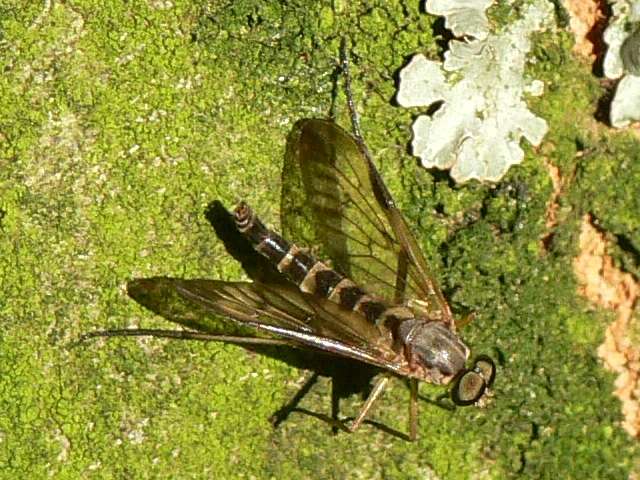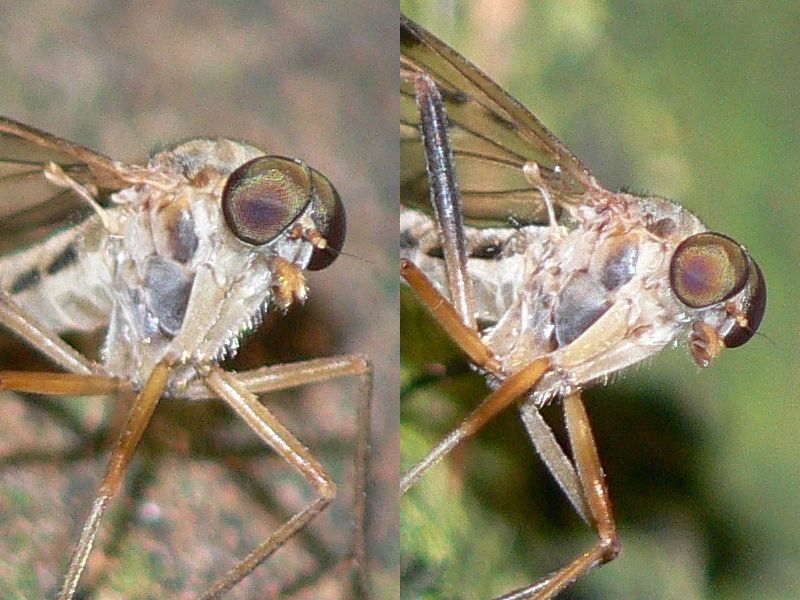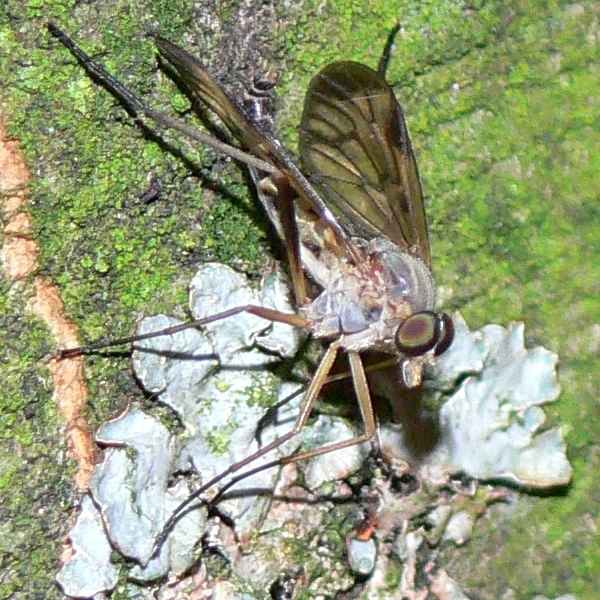Diptera.info :: Identification queries :: Diptera (adults)
|
Rhagio strigosus?
|
|
| Juergen Peters |
Posted on 31-07-2006 21:54
|
|
Member Location: northwest Germany Posts: 14347 Joined: 11.09.04 |
Hello! These Rhagionids numerously inhabited a tree trunk in our garden today (Germany). Is this Rhagio strigosus? Thanks in advance!  
Best regards, Jürgen -=-=-=-=-=-=-=-=-=-=-=-=-=-=-=-= Juergen Peters Borgholzhausen, Germany WWW: http://insektenfo... -=-=-=-=-=-=-=-=-=-=-=-=-=-=-=-= |
| Tony Irwin |
Posted on 01-08-2006 21:45
|
|
Member Location: Norwich, England Posts: 7326 Joined: 19.11.04 |
Could be, but it is difficult to separate male strigosus from scolopaceus. Also there is another species, latipennis that occurs in Germany. In this species the wings are rather broader than the others, and this may be what you have photographed. It is difficult to tell from the angle of the shot.  I only have scolopaceus in my collection, so perhaps someone with all the species can compare and give you a better answer! I only have scolopaceus in my collection, so perhaps someone with all the species can compare and give you a better answer! 
Tony ---------- Tony Irwin |
|
|
|
| Juergen Peters |
Posted on 01-08-2006 23:13
|
|
Member Location: northwest Germany Posts: 14347 Joined: 11.09.04 |
Hello Tony, thanks for your reply! Tony Irwin wrote: Could be, but it is difficult to separate male strigosus from scolopaceus. My first thought was indeed R. scolopaceus, but isn't that a spring species? They were numerous here, but have disappeared some weeks ago. Additionally the current flies are considerably smaller than R. scolopaceus. Also there is another species, latipennis that occurs in Germany. In this species the wings are rather broader than the others, and this may be what you have photographed. It is difficult to tell from the angle of the shot. Of course the wings seem relatively broad to me. I have added another photo more from above. Juergen Peters attached the following image:  [63.22Kb] Edited by Juergen Peters on 01-08-2006 23:15 Best regards, Jürgen -=-=-=-=-=-=-=-=-=-=-=-=-=-=-=-= Juergen Peters Borgholzhausen, Germany WWW: http://insektenfo... -=-=-=-=-=-=-=-=-=-=-=-=-=-=-=-= |
| Paul Beuk |
Posted on 02-08-2006 07:15
|
|
Super Administrator Location: Netherlands Posts: 19403 Joined: 11.05.04 |
From my key I understand that both R. strigosus and R. latipennis should have yellowish sides of the thorax, of about the same colour as the femora. In addition, R. latipennis has wings that are only 2.5 times as long as wide. Here it appears to be about 3. So in my opinion, I think it is R. scolopaceus. Apparently the species is getting scarcer in July and August, but there is even a Danish record from early September. Speculation: It has been hot and dry for quite some time. I have noticed some species that appeared to postpone their emergence until the surroundings became more humid. Maybe the case with your Rhagio's, too? Paul - - - - Paul Beuk on https://diptera.info |
| Tony Irwin |
Posted on 02-08-2006 09:06
|
|
Member Location: Norwich, England Posts: 7326 Joined: 19.11.04 |
The more dorsal view shows that the wings are not so broad, so I agree with Paul that latipennis is unlikely. However, I understand that the thoracic colour of the male strigosus can be grey sometimes, so I'm not certain that this is scolopaceus. There is a difference in the antennal shape, with scolopaceus having a pointed ventral projection, but I cannot tell from the photos exactly what shape they are. If you can get a detailed close-up lateral shot of the head, we may be able to be sure! Don't worry too much about flight times or size - as Paul says, scolopaceus can fly much later than some books suggest, and small individuals do occur - depending on conditions during development. Tony ---------- Tony Irwin |
|
|
|
| Paul Beuk |
Posted on 02-08-2006 09:43
|
|
Super Administrator Location: Netherlands Posts: 19403 Joined: 11.05.04 |
My main reason for concern that it may NOT be R. scolopaceus would be the rather darkish impression I get from the specimens. Still, I have not seen that the overall colour of R. strigosus should be darker and that does not fit with the yellowish lateral part of the thorax either...
Paul - - - - Paul Beuk on https://diptera.info |
| Juergen Peters |
Posted on 02-08-2006 14:58
|
|
Member Location: northwest Germany Posts: 14347 Joined: 11.09.04 |
Hello Paul and Tony, many thanks for your explanations! Tony Irwin wrote: There is a difference in the antennal shape, with scolopaceus having a pointed ventral projection, but I cannot tell from the photos exactly what shape they are. If you can get a detailed close-up lateral shot of the head, we may be able to be sure! Unfortunately I have no real lateral shot, the pics below are the best I have taken. I would try to get better photos, but today it is raining all the time :-(. Juergen Peters attached the following image:  [89.88Kb] Edited by Juergen Peters on 02-08-2006 14:59 Best regards, Jürgen -=-=-=-=-=-=-=-=-=-=-=-=-=-=-=-= Juergen Peters Borgholzhausen, Germany WWW: http://insektenfo... -=-=-=-=-=-=-=-=-=-=-=-=-=-=-=-= |
| Zeegers |
Posted on 02-08-2006 21:03
|
|
Member Location: Soest, NL Posts: 19224 Joined: 21.07.04 |
I have to agree with Tony. A much more crucial and better feature than the colouration of pleurae is the length of the third antennal segment. The third antennal segment is definitely short on the picture, unless it is very misleading, that is, shorter than the second. This rules out Rh. scolopaceus. Moreover, as pointed out by Paul, July is clearly not in favour of scolopaceus. In latipennis, in males the eyes should be separated, which I don't see on the picture. So in my opinion Juergen was right from the beginning: strigosus. Theo Zeegers |
|
|
|
| Juergen Peters |
Posted on 03-08-2006 22:41
|
|
Member Location: northwest Germany Posts: 14347 Joined: 11.09.04 |
Hello, Theo! Moreover, as pointed out by Paul, July is clearly not in favour of scolopaceus. In latipennis, in males the eyes should be separated, which I don't see on the picture. So in my opinion Juergen was right from the beginning: strigosus. Thanks a lot! Best regards, Jürgen -=-=-=-=-=-=-=-=-=-=-=-=-=-=-=-= Juergen Peters Borgholzhausen, Germany WWW: http://insektenfo... -=-=-=-=-=-=-=-=-=-=-=-=-=-=-=-= |
| Juergen Peters |
Posted on 17-09-2006 23:46
|
|
Member Location: northwest Germany Posts: 14347 Joined: 11.09.04 |
Hello! Zeegers wrote: Moreover, as pointed out by Paul, July is clearly not in favour of scolopaceus. By the way: those flies are still around here in our garden now in mid September (pic from yesterday). Juergen Peters attached the following image:  [53.14Kb] Best regards, Jürgen -=-=-=-=-=-=-=-=-=-=-=-=-=-=-=-= Juergen Peters Borgholzhausen, Germany WWW: http://insektenfo... -=-=-=-=-=-=-=-=-=-=-=-=-=-=-=-= |
| Jump to Forum: |













